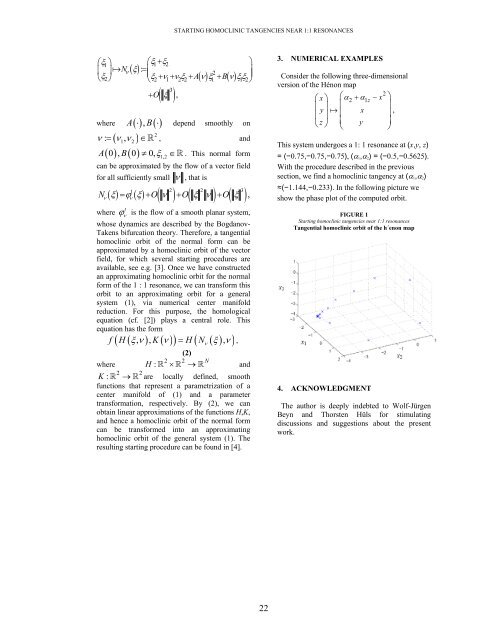matemática - Blog de ESPOL - Escuela Superior Politécnica del Litoral
matemática - Blog de ESPOL - Escuela Superior Politécnica del Litoral
matemática - Blog de ESPOL - Escuela Superior Politécnica del Litoral
Create successful ePaper yourself
Turn your PDF publications into a flip-book with our unique Google optimized e-Paper software.
+ O<br />
3<br />
( ξ )<br />
STARTING HOMOCLINIC TANGENCIES NEAR 1:1 RESONANCES<br />
⎛ξ1⎞ ⎛ξ1+ ξ2<br />
⎞<br />
⎜ ⎟Nν( ξ)<br />
: = ⎜ 2<br />
ξ ⎜ ⎟<br />
2 ξ2+ ν1+ ν2ξ2+ A( ν) ξ1 + B(<br />
ν) ξξ ⎟<br />
⎝ ⎠ ⎝ 1 2⎠<br />
where A( ) , B(<br />
)<br />
ν : ( ν1, ν2)<br />
2<br />
A( 0, ) B( 0) 0, ξ1,2<br />
,<br />
⋅ ⋅ <strong>de</strong>pend smoothly on<br />
= ∈ , and<br />
≠ ∈ . This normal form<br />
can be approximated by the flow of a vector field<br />
for all sufficiently small ν , that is<br />
1<br />
2 2 3<br />
( ξ) ϕ ( ξ) ( ν ) ( ξ ν ) ( ξ )<br />
N = + O + O + O ,<br />
ν ν<br />
t<br />
where ϕ ν is the flow of a smooth planar system,<br />
whose dynamics are <strong>de</strong>scribed by the Bogdanov-<br />
Takens bifurcation theory. Therefore, a tangential<br />
homoclinic orbit of the normal form can be<br />
approximated by a homoclinic orbit of the vector<br />
field, for which several starting procedures are<br />
available, see e.g. [3]. Once we have constructed<br />
an approximating homoclinic orbit for the normal<br />
form of the 1 : 1 resonance, we can transform this<br />
orbit to an approximating orbit for a general<br />
system (1), via numerical center manifold<br />
reduction. For this purpose, the homological<br />
equation (cf. [2]) plays a central role. This<br />
equation has the form<br />
f ( H( ξ, ν) , K( ν) ) = H( Nν( ξ) , ν)<br />
,<br />
(2)<br />
2 2 N<br />
where H : × →<br />
and<br />
2 2<br />
K : → are locally <strong>de</strong>fined, smooth<br />
functions that represent a parametrization of a<br />
center manifold of (1) and a parameter<br />
transformation, respectively. By (2), we can<br />
obtain linear approximations of the functions H,K,<br />
and hence a homoclinic orbit of the normal form<br />
can be transformed into an approximating<br />
homoclinic orbit of the general system (1). The<br />
resulting starting procedure can be found in [4].<br />
22<br />
3. NUMERICAL EXAMPLES<br />
Consi<strong>de</strong>r the following three-dimensional<br />
version of the Hénon map<br />
2<br />
⎛x⎞ ⎛α2 + α1z−<br />
x ⎞<br />
⎜y⎟ ⎜ ⎟<br />
<br />
⎜<br />
x<br />
⎟<br />
,<br />
⎜ ⎟<br />
⎝z⎠ ⎜ y ⎟<br />
⎝ ⎠<br />
This system un<strong>de</strong>rgoes a 1: 1 resonance at (x,y, z)<br />
= (−0.75,−0.75,−0.75), (α1,α2) = (−0.5,−0.5625).<br />
With the procedure <strong>de</strong>scribed in the previous<br />
section, we find a homoclinic tangency at (α1,α2)<br />
≈(−1.144,−0.233). In the following picture we<br />
show the phase plot of the computed orbit.<br />
FIGURE 1<br />
Starting homoclinic tangencies near 1:1 resonances<br />
Tangential homoclinic orbit of the h´enon map<br />
4. ACKNOWLEDGMENT<br />
The author is <strong>de</strong>eply in<strong>de</strong>bted to Wolf-Jürgen<br />
Beyn and Thorsten Hüls for stimulating<br />
discussions and suggestions about the present<br />
work.

















